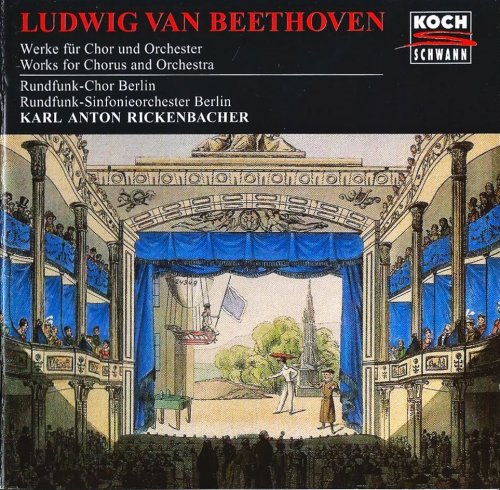Karl Anton Rickenbacher - Beethoven: Works for Chorus and Orchestra (1995)

Artist: Karl Anton Rickenbacher
Title: Beethoven: Works for Chorus and Orchestra
Year Of Release: 1995
Label: Koch Schwann
Genre: Classical
Quality: FLAC (image+.cue,scans)
Total Time: 53:52
Total Size: 245 Mb
WebSite: Album Preview
Tracklist: Title: Beethoven: Works for Chorus and Orchestra
Year Of Release: 1995
Label: Koch Schwann
Genre: Classical
Quality: FLAC (image+.cue,scans)
Total Time: 53:52
Total Size: 245 Mb
WebSite: Album Preview
01. Meerstille und glückliche Fahrt op.112 [0:08:50.07]
02. Opferlied op.121a [0:05:55.00]
03. Opferlied op.121b [0:06:13.03]
04. Bundeslied op.122 [0:04:11.72]
05. "Wo sind die Pulse jugendlich jagen" WoO 98 [0:06:59.73]
06. Musik zu "Leonore Prohaska" - I. Krieger-Chor [0:03:05.00]
07. Musik zu "Leonore Prohaska" - II. Romance [0:02:56.72]
08. Musik zu "Leonore Prohaska" - III. Melodram für Sprecherin und Glasharmonika [0:02:30.08]
09. Musik zu "Leonore Prohaska" - IV. Trauermarsch [0:06:35.57]
10. Triumphmarsch [0:02:47.13]
11. Marsch für Militärmusik No.1 WoO 18 [0:01:29.07]
12. Marsch für Militärmusik No.2 WoO 19 [0:03:20.18]
Performers:
Bodil Arnesen - soprano
Renate Erxleben - harp
Konstantin Restle - glass harmonica
Rundfunkchor Berlin
Rundfunk-Sinfonieorchester Berlin
Karl Anton Rickenbacher – conductor
This is a collection of chips from the great man’s workbench, some of them thin shavings but none of them without some interest. Perhaps the weirdest assemblage is the incidental music for a drama called Leonore Prohaska, a play about a girl who dresses up as a man and sets off heroically – but do not be misled by comparisons with any other Beethoven Leonores: this one appears to have been a Sweet Polly Oliver who fought and died as a soldier in the Wars of Liberation. Censorship silenced the play, but not before Beethoven had composed four numbers for it. There is a vigorous “Warriors’ Chorus”, quite a pretty “Romance” for soprano and harp (nicely sung here), and a melodrama for the maddening combination of reciter and glass armonica (an instrument once believed to be literally maddening). The last piece is a funeral march, an orchestration made at the playwright’s request of the slow movement of Beethoven’s Op. 26 Piano Sonata, subtitled “Marcia funebre sulla morte d’un Eroe”. Transposed from A flat minor up to B minor, this is an almost note for note orchestration, fascinating for the art with which Beethoven brings out the contrapuntal lines buried deep in the sombrely pacing chords. No pianist should ever play the sonata without having heard this.
For the rest, there are some firmly sung choruses that include a characteristic setting of Goethe’s Calm sea and prosperous voyage (reflective then jolly), a so-called Bundeslied (jolly), two versions of the Op. 121 Opferlied and a strong chorus from the play, Die Weihe des Hauses (for the opening of the Josephstadttheater). There are also some marches, one of them for horses. That is to say, it was for an equestrian performance, though one doubts if even the Lippizaners of the Vienna Riding School could manage the composer’s suggestion that his music might make them turn somersaults.
For the rest, there are some firmly sung choruses that include a characteristic setting of Goethe’s Calm sea and prosperous voyage (reflective then jolly), a so-called Bundeslied (jolly), two versions of the Op. 121 Opferlied and a strong chorus from the play, Die Weihe des Hauses (for the opening of the Josephstadttheater). There are also some marches, one of them for horses. That is to say, it was for an equestrian performance, though one doubts if even the Lippizaners of the Vienna Riding School could manage the composer’s suggestion that his music might make them turn somersaults.

DOWNLOAD FROM ISRA.CLOUD
Karl Anton Rickenbacher Beethoven Works for Chorus and Orchestra 95 0712.rar - 245.4 MB
Karl Anton Rickenbacher Beethoven Works for Chorus and Orchestra 95 0712.rar - 245.4 MB







![Henry Threadgill, Ensemble Double Up - Old Locks and Irregular Verbs (2016) [Hi-Res] Henry Threadgill, Ensemble Double Up - Old Locks and Irregular Verbs (2016) [Hi-Res]](https://img.israbox.com/img/2026-01/11/p30x0pecr83e6f3do67qdh3yo.jpg)
